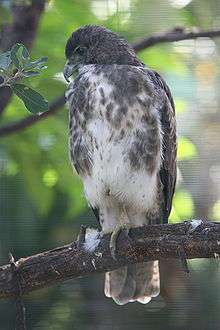Hawaiian hawk
| Hawaiian hawk | |
|---|---|
 | |
| At Honolulu Zoo, Hawaii | |
| Scientific classification | |
| Kingdom: | Animalia |
| Phylum: | Chordata |
| Class: | Aves |
| Order: | Falconiformes (or Accipitriformes, q.v.) |
| Family: | Accipitridae |
| Genus: | Buteo |
| Species: | B. solitarius |
| Binomial name | |
| Buteo solitarius (Peale, 1848) | |
The Hawaiian hawk or ʻio (Buteo solitarius) is a raptor of the Buteo genus endemic to Hawaiʻi, currently restricted to the Big Island. Buteos tend to be easily recognized by their bulky bodies relative to their overall length and wingspan. The ʻio is the only hawk that is native to Hawaiʻi, and fossil evidence indicates that it inhabited the island of Hawaiʻi, Molokaʻi, Oʻahu, and Kauaʻi at one time.[2] Today, it is known to breed only on the Big Island, in stands of native ʻōhiʻa lehua (Metrosideros polymorpha) trees. The species is protected as an endangered species in the United States. However, the IUCN classifies the species as Near Threatened.[1]
Description
The Hawaiian hawk measures approximately 40 to 46 centimeters (16 to 18 in) in length. The female, which weighs 605 g (21.3 oz) on average, is larger than the male, which averages 441 g (15.6 oz).[3] Two color phases exist: a dark phase (dark brown head, breast, and underwings), and a light color phase (dark head, light breast and light underwings). Feet and legs are yellowish in adults and greenish in juveniles. During breeding season one of the pair, possibly the female, has a distinctive yellow forecap area just above the upper mandible.
Threats
Common threats to the ʻio are illegal shootings, the degradation of their native forest habitat, poisoning, vehicle collisions, starvation, and predation from other animals.
Lifestyle
This solitary hawk remains in and defends its territories year round. They nest from March through September, and usually lay only one egg but sometimes they could lay up to three in their clutch. The female does the majority of sitting during the 38 days of incubation, while the male does the majority of the hunting. After the egg is hatched, the female only allows the male to visit when delivering food to the nest. The chick fledges at seven or eight weeks. Fifty to seventy percent of the nests successfully fledge young.
The ʻio usually hunts from a stationary position, but can also dive on prey from the air. It feeds on rats, small birds, stream animals, crickets, praying mantises, millipedes, centipedes, lizards such as jackson's chameleon, and occasionally worms. It will also feed on the Hawaiian crow, a Hawaiian bird which is extinct in the wild. They are opportunistic predators and are versatile in their feeding habits. They have a shrill and high-pitched call much like their Hawaiian name: "eeeh-oh." They are very noisy during the breeding season. ʻIo are strong fliers.
The Hawaiian hawk was a royal symbol in Hawaiian legend, and it is sometimes called “ʻiolani,” or “exalted hawk”, which was the name of Kamehameha IV and the ʻIolani Palace.
References
- 1 2 BirdLife International (2012). "Buteo solitarius". IUCN Red List of Threatened Species. Version 2013.2. International Union for Conservation of Nature. Retrieved 26 November 2013.
- ↑ "ʻIo" (PDF). Hawaii’s Comprehensive Wildlife Conservation Strategy. State of Hawaiʻi. 2005-10-01. Retrieved 2009-03-20.
- ↑
- "Hawaiian Hawk / Buteo solitarius / ʻIo". Fish and Wildlife Pacific Office. United States Fish and Wildlife Service.
External links
| Wikimedia Commons has media related to Buteo solitarius. |
